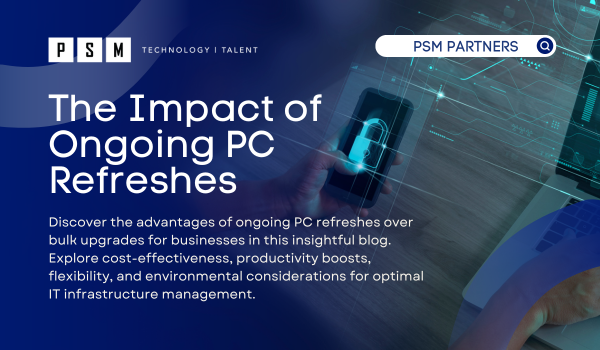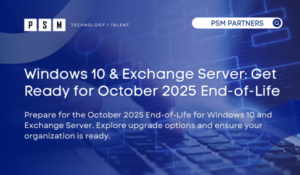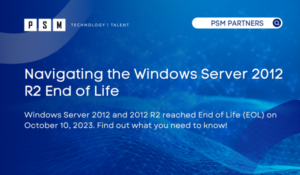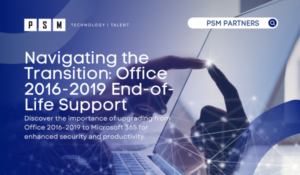Table of Contents
ToggleIn today’s fast-paced digital world, technology is the lifeblood of businesses. It drives productivity, streamlines operations, and helps maintain a competitive edge. Central to this tech ecosystem are personal computers (PCs). Businesses are constantly grappling with the challenge of keeping their PC infrastructure up-to-date. Whether through ongoing refreshes or bulk upgrades, businesses strive to maintain efficiency and security in their operations. A notable concern highlighted in a 2021 report by Cybersecurity Insiders is the increasing prevalence of employees bringing their own devices (BYOD) into the workplace, with 70% of organizations allowing this practice. However, this trend brings with it significant security risks, with around 30% of businesses citing security concerns as the primary barrier to adopting BYOD policies. As organizations navigate these challenges, finding the right balance between flexibility and security remains paramount in ensuring smooth operations and safeguarding sensitive data. This blog will explore why ongoing PC refreshes are the way to go and how they can greatly benefit companies compared to bulk upgrades.
Ongoing Refreshes vs. Bulk Upgrades - Which is Right for Your Business?
Inevitably, every IT administrator faces the challenge of managing aging equipment. When this situation arises, administrators are given the option of upgrading their current equipment or investing in new equipment. However, the question remains: Should they opt for the periodic, more incremental replacement of PCs, or should they undertake massive bulk upgrades every few years? Although both options offer opportunities for IT professionals to improve their technical capabilities, the decision must be carefully analyzed based on the specific objectives, budgetary constraints, and IT landscape of the business. Let’s delve deeper into these distinctions:
Hardware Refresh
A hardware refresh, also known as a technology refresh, is the process of upgrading or replacing outdated computer hardware components within an organization’s infrastructure to improve performance, security, and efficiency. This proactive approach helps businesses maintain their competitiveness by leveraging the latest advancements in technology to optimize operations and support growth. Key benefits of a hardware refresh include improved productivity, reduced downtime, improved data security, and improved support for emerging software applications.
Bulk Upgrade
A bulk hardware upgrade refers to the simultaneous replacement or upgrade of multiple hardware components within a system or infrastructure. This strategic approach helps businesses improve performance, efficiency, and reliability across their IT infrastructure. Bulk hardware upgrades typically involve servers, storage devices, networking equipment, and other essential hardware components. Implementing a bulk hardware upgrade can streamline operations, increase productivity, and ensure scalability to meet growing demands.
Exploring Differences Between Hardware Refreshes and Bulk Upgrades:
Both hardware refreshes and bulk upgrades play crucial roles in optimizing IT environments, but understanding their nuances helps companies tailor their approach to meet specific needs and objectives effectively. Below are distinctions between the two approaches:
Cost Effectiveness
Bulk upgrades often involve a substantial initial investment, which may strain a company’s financial resources. Conversely, ongoing refreshes offer the advantage of spreading costs gradually over time, alleviating budget constraints. This strategy not only lessens the immediate financial burden but also ensures that the technology remains up to date. Additionally, it allows businesses to leverage decreasing hardware expenses, boosting long-term cost-effectiveness. However, ongoing refreshes demand careful planning to ensure seamless integration and compatibility. Despite this, the gradual investment approach offers flexibility and adaptability, aligning with changing business needs. By strategically balancing upfront costs with long-term benefits, companies can optimize their IT infrastructure, driving efficiency and competitiveness in the market.
Increased Productivity
Productivity is the lifeblood of any business. Newer PCs are equipped with faster processors, better memory, and superior graphics capabilities, all of which translate to improved efficiency. With ongoing refreshes, the risk of downtime is reduced, ensuring that employees can work uninterrupted, which, in turn, maximizes efficiency and output. This heightened productivity isn’t just good for the bottom line; it also leads to increased job satisfaction. On the other hand, a potential downside to ongoing refreshes is the disruption they can cause to workflow continuity. Implementing hardware updates requires time for installation, configuration, and potentially troubleshooting. During this process, employees may experience downtime or interruptions to their work, which can temporarily decrease productivity.
Flexibility and Scalability
In today’s dynamic business environment, flexibility and scalability are not just buzzwords; they’re business imperatives. Ongoing refreshes allow companies to remain adaptable to changing technology and business requirements. Instead of waiting for a bulk upgrade cycle, ongoing refreshes facilitate the gradual introduction of newer technology into the infrastructure. This staged approach ensures that companies can benefit from the latest innovations without significant disruptions. Ongoing refreshes also ensure compatibility with legacy systems. Many companies rely on legacy applications and software that may not be immediately compatible with newer hardware. By implementing ongoing refreshes, businesses can synchronize their technology upgrades with the necessary software updates, ensuring a seamless transition without risking compatibility issues.
Technological Advancements
Ongoing refreshes ensure that companies always have access to the latest hardware and software innovations. New PCs boast superior performance, expanded storage, and improved security, effectively protecting against emerging cyber threats like malware. However, these ongoing updates necessitate continuous employee training and adaptation to new technologies, potentially disrupting productivity initially. Despite the initial challenges, the long-term benefits of enhanced productivity and security are substantial. Nevertheless, to ensure smooth transitions and sustained efficiency, companies must commit to ongoing investments in training and change management strategies. By prioritizing these efforts, organizations can maximize the advantages of continuous updates while mitigating potential disruptions.
Reduced Risks and Maintenance
Minimizing risks and optimizing maintenance processes are paramount for ensuring business continuity. Ongoing refreshes play a crucial role in risk reduction by mitigating hardware failures and compatibility issues. As older PCs are inherently more susceptible to malfunctions, they pose a higher risk of increased downtime and potential data loss. Continuously refreshing PCs helps organizations proactively manage these risks, safeguarding critical business operations. However, a notable drawback of ongoing refreshes is the associated cost of frequent hardware replacements. While periodic refreshes contribute to risk mitigation, they necessitate a continuous financial investment in acquiring new hardware. This ongoing expenditure may strain the company’s budget, particularly if refresh cycles are frequent or if a substantial number of devices require upgrading. Furthermore, the disposal of old hardware adds to the financial burden, requiring proper recycling or disposal methods.
Environmental Considerations
Ongoing refreshes also have a positive impact on the environment. By spreading out the disposal of old equipment, companies can reduce electronic waste, contributing to more sustainable practices and corporate responsibility. Recycling and responsibly disposing of old PCs also prevent harmful materials from entering landfills, which can have long-lasting environmental consequences.
Leveraging PSM Partners for Your Hardware Refresh or Bulk Upgrade Needs
In the ongoing discussion regarding the choice between continuous PC updates and bulk upgrades, the strategy of ongoing refreshes emerges as the favored approach. Effectively implementing this strategy requires the development of a strategic plan. Companies can devise a phased update plan that aligns with their financial resources and business goals. PSM’s Deployment Services draw upon real-world experience and proven methodologies, resulting in expedited timelines for environments of all sizes and complexities, thus mitigating potential costly risks. As part of our continuous process, we oversee Communications, Coordination, and Scheduling for all users, ensuring proper expectations are set. Immediately following any changes made to your environment, our dedicated on-site staff stands ready to assist affected users.
Before embarking on IT procurement and the installation of new software and equipment, it is advisable to consult our experts at PSM Partners. We can support your IT procurement team in acquiring the necessary hardware and software additions, ensuring their safe and secure integration into your existing infrastructure. With meticulous planning, ongoing updates can offer a consistent and strategic approach to keeping your organization’s IT infrastructure current. In a landscape characterized by constant change, maintaining freshness and adaptability is key to achieving success. For more information, reach out today.
Related Insights
Windows 10 & Exchange Server: Get Ready for October 2025 End-of-Life
At this point, most organizations should be aware of the...
Read MoreNavigating the Windows Server 2012 R2 End of Life: Key Steps to Take
In late 2023, Microsoft Windows Server 2012 and 2012 R2...
Read MoreEnhancing Security and Privacy on Windows 11: Best Practices and Tips
With the end of life support for Microsoft’s Office 2016...
Read MoreNavigating the Transition: Office 2016-2019 End-of-Life Support
The Microsoft Office Suite has been a cornerstone of productivity...
Read MoreAbout the Author

Cody Muller
Cody Muller is a highly accomplished IT Project Manager specializing in Healthcare and Higher Education. With over seven years of experience, Cody has led projects with seamless wireless infrastructure deployment across 28 nationwide locations, serving over 50,000 onsite staff and students. His expertise includes developing sustainable IT processes for new college campuses and delivering strategic services to large healthcare organizations, ensuring exceptional end-user satisfaction.





